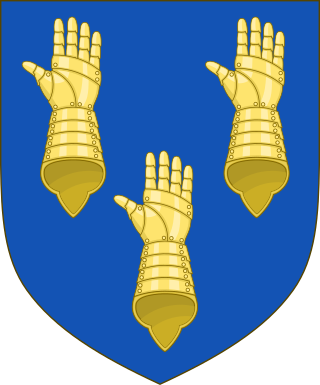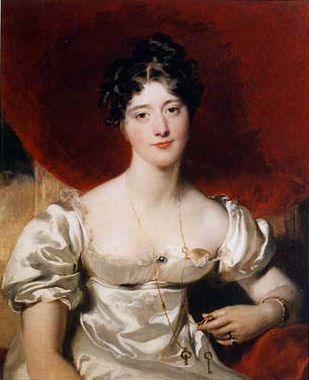
Marquess of Londonderry, of the County of Londonderry, is a title in the Peerage of Ireland.

Baron Barnard, of Barnard Castle in the Bishopric of Durham, is a title in the Peerage of England. It was created in 1698 for Christopher Vane, who had previously served as a member of parliament for County Durham and Boroughbridge. Vane was the son of Sir Henry Vane the Younger and grandson of Sir Henry Vane the Elder. His grandson, the third Baron, notably served as Paymaster of the Forces and as Lord Lieutenant of County Durham. In 1754 he was created Viscount Barnard and Earl of Darlington, both in the County Palatine of Durham. Lord Darlington was the husband of Lady Grace FitzRoy, daughter of Charles FitzRoy, 2nd Duke of Cleveland, the illegitimate son of King Charles II by his mistress Barbara Villiers, 1st Duchess of Cleveland.

Earl of Antrim is a title that has been created twice, both times in the Peerage of Ireland and both times for members of the MacDonnell family, originally of Scottish origins.

Charles William Vane, 3rd Marquess of Londonderry, was an Anglo-Irish nobleman, a British soldier and a politician. He served in the French Revolutionary Wars, in the suppression of the Irish Rebellion of 1798, and in the Napoleonic wars. He excelled as a cavalry commander in the Peninsular War (1807–1814) under John Moore and Arthur Wellesley.
This is a list of people who have served as Lord Lieutenant of Hampshire. Since 1688, all the Lords Lieutenant have also been Custos Rotulorum of Hampshire. From 1889 until 1959, the administrative county was named the County of Southampton.

This is a list of people who have served as Lord Lieutenant of Cambridgeshire. The title Lord Lieutenant is given to the British monarch's personal representative in the counties of the United Kingdom. Lord Lieutenants are supported by an appointed Vice Lord Lieutenant and Deputy Lieutenants. Since 1715, all Lord Lieutenants have also been Custos Rotulorum of Cambridgeshire.
This is an incomplete list of people who have served as Lord Lieutenant of Norfolk. Since 1689, all Lord Lieutenants have also been Custos Rotulorum of Norfolk.
This is an incomplete list of people who have served as Lord Lieutenant of Somerset. Since 1714, all Lord Lieutenants have also been Custos Rotulorum of Somerset.

William Henry Vane, 1st Duke of Cleveland, KG, styled Viscount Barnard until 1792 and known as The Earl of Darlington between 1792 and 1827 and as The Marquess of Cleveland between 1827 and 1833, was a British landowner and politician.
This is a list of people who have served as Lord-Lieutenant of Suffolk. Since 1642, all Lord Lieutenants have also been Custos Rotulorum of Suffolk.

This is a list of lords lieutenants of County Down.
This is a list of people to have been Lord Lieutenant of County Londonderry.

George Henry Robert Charles William Vane-Tempest, 5th Marquess of Londonderry, KP, styled Viscount Seaham between 1823 and 1854 and known as The Earl Vane between 1854 and 1872, was a British aristocrat, businessman, diplomat and Conservative politician.

Sir Henry Vane-Tempest, 2nd Baronet was a British politician. In early life his name was Henry Vane. He changed his name to Vane-Tempest when he inherited from his uncle John Tempest, Jr. in 1793.

The Tempest family was an English recusant family that originated in western Yorkshire in the 12th century.
Vane is a surname. Notable people with the surname include:

Frances Anne Vane, Marchioness of Londonderry was a wealthy English heiress and noblewoman. She was the daughter of Sir Henry Vane-Tempest, 2nd Baronet. She married Charles William Stewart, 1st Baron Stewart. She became a marchioness in 1822 when Charles succeeded his half-brother as 3rd Marquess of Londonderry.

Charles Stewart Vane-Tempest-Stewart, 6th Marquess of Londonderry,, styled Viscount Castlereagh between 1872 and 1884, was a British Conservative politician, landowner and benefactor, who served in various capacities in the Conservative administrations of the late 19th and early 20th centuries. After succeeding his father in the marquessate in 1884, he was Lord-Lieutenant of Ireland between 1886 and 1889. He later held office as Postmaster General between 1900 and 1902 and as President of the Board of Education between 1902 and 1905. A supporter of the Protestant causes in Ulster, he was an opponent of Irish Home Rule and one of the instigators of the formal alliance between the Conservative Party and the Liberal Unionists in 1893.

The Vane, later Vane-Tempest Baronetcy, of Long Newton in the County of Durham, was a title in the Baronetage of Great Britain. The Vane baronetcy was created on 13 July 1782 for Reverend Henry Vane, D.D., second son of George Vane of Long Newton. He was a descendant of Sir Henry Vane the Elder. Vane married Frances Tempest, daughter of John Tempest of Sherburne, Durham. When her brother, John Tempest Sr., died in 1771 naming the baronet's son as his heir, the younger Vane assumed by Royal licence the additional surname of Tempest in accordance with his uncle's will. Thus, when the 1st baronet died in 1794, his son became Baronet Vane-Tempest. This second baronet represented both the city and county of Durham in Parliament and was a well-known sportsman. He married Anne MacDonnell, 2nd Countess of Antrim. They had one child Lady Frances Anne, who married Lord Charles Stewart, later 3rd Marquess of Londonderry, who assumed the surname of Vane and in 1823 was named Earl Vane and Viscount Seaham. When Vane-Tempest died in 1813, the baronetcy became extinct.











